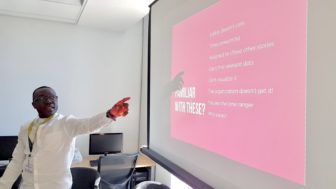
iJourno Africa founder Nana Boakye-Yiadom is on a mission to help newsrooms incorporate data into their stories. Photo: Adèle Humbert
Nana Boakye-Yiadom’s first data radio story explored how farmers in rural Ghana used simple SMS technology to access real-time prices on crops, which helped them make a profit. “Phone Farming” won the Best Online Story award for 2013 from the Ghana Journalists Awards.
Speaking on a panel at the 10th Global Investigative Journalism Conference in Johannesburg, the Citi 97.3 FM reporter and founder of iJourno Africa said data absolutely made the story more powerful, and he wants other newsroom to incorporate data in their reporting.
Boakye-Yiadom shared his experience and tips with GIJN on the sidelines of #GIJC17.
What challenges do you face when you want to do a data story?
When I started to work on the data online version of Phone Farming I was like ‘why couldn’t I just type my story?’ It sounded too complicated. I had already gotten the numbers and I had gone to the field to collect data and interview people so I had the information already. But the real challenge was to put it into a data form and to visualize it. I used a Ghana map to show where I’ve been. It was very simple but it worked very well because it was sharable.
What are the challenges when you want to start a data journalism project in Africa?
The biggest challenge is mentality. People have this perception that the data is too complicated. You need to show that it’s easy to do and then you can produce quality journalism pieces. In certain parts of Africa you also have to deal with some technical issues: the Internet is quite expensive. Access to information and resources is one of the biggest challenges in Africa, compared to the most of the Western countries. African people who are interested don’t have the training and the technologies to get it done. At a big conference like the Global Investigative Journalism Conference, you can learn about the huge amount of tools you can use.
The last biggest challenge is finding the relevant data in Ghana — the authorities don’t want to share it. But now we are all learning how to get the information and finding other ways to access the data. Sometimes you can get them from international or local NGOs, for instance.
Why is data crucial to make the story more accessible?
Data makes the story more accessible because it makes it more sharable. And that’s what you want as a journalist — you want people to share your stories because if it’s not sharable, it means that your audience is limited. So once your story is sharable it can go viral.
What are your favorite data tools?
- Canva to tell more sharable stories
- Piktochart for easy data visualization
- Data Wrapper to create maps
What are four things you would you say to convince a non-data journalist to use data?
- It’s not as complicated as you might think.
- The amount of time you’ll spend on learning data journalism will pay off.
- Your stories will be more powerful and you’ll add value to yourself as a journalist.
- Be open-minded, find other people in the field who know data and connect with them
Tips for small newsroom editors:
Step 1. Introduce the concept to the whole news team
Step 2. Wait for the chaff to fall off and and pick the genuinely interested bunch
Step 3. Move with the hard cores
Step 4. Grow the number
Step 5. Make it a strategic part of your news product
Step 6. Call the shots now – you’re either in or out
Step 7. Be consistent
Step 8. Turn your attention on leadership now
 Adèle Humbert is an investigative radio and data journalist based in Paris. She worked on the Paradise Papers at Radio France with the ICIJ. She previously investigated potential wrongful convictions at the Medill Justice Project in the United States and produced “Shaken” an award-winning long-form audio story.
Adèle Humbert is an investigative radio and data journalist based in Paris. She worked on the Paradise Papers at Radio France with the ICIJ. She previously investigated potential wrongful convictions at the Medill Justice Project in the United States and produced “Shaken” an award-winning long-form audio story.
